Rome: soldier emperors to Costantine
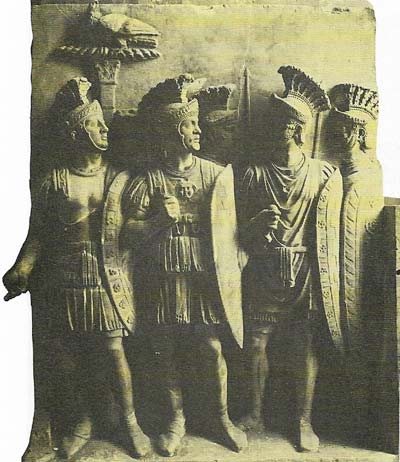
Figure 1. The Praetorian Guard were the elite bodyguards of the emperor. They were the first body of Roman soldiers to realize they had the power to make emperors and, if need be, to break them too. During the third century their example was followed by troops in the provinces. Anarchy ensued as local garrisons set up their own emperors and tried to dominate the empire.
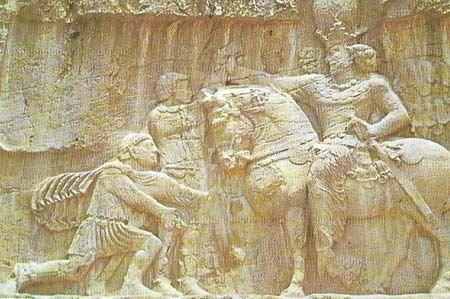
Figure 2. The Emperor Valerian was forced to kneel to the Persian ruler in the worst disaster that befell Rome in the third century. The internal chaos of the empire coincided with renewed pressure from barbarian tribes in the West and from the Persians in the East. The cohesion of the empire was further weakened as threatened areas took action independently of Rome to defend themselves.
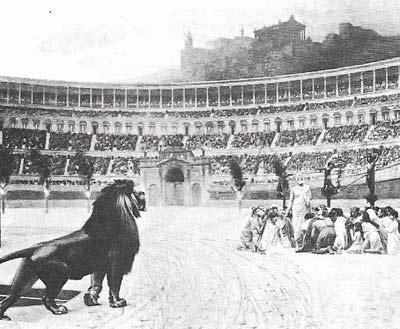
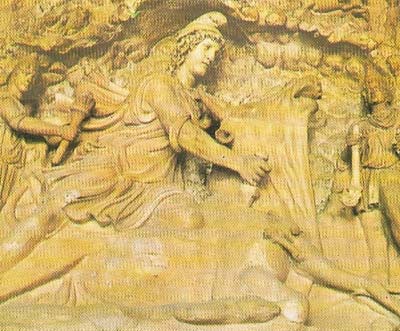
Figure 3. Roman persecution of Christians (top), which reached its height under Decius and Valerian, contrasted with general religious toleration, limited only by the importance given to the unity of the empire. Provided the adherents of a religion were prepared to pay homage to the divine emperor, they were free to worship and make convents. Many Eastern cults such as Mithraism (bottom) flourished but the exclusiveness of Christians and their refusal to do homage caused them to be treated as a treasonable sect and to be deprived of citizenship.
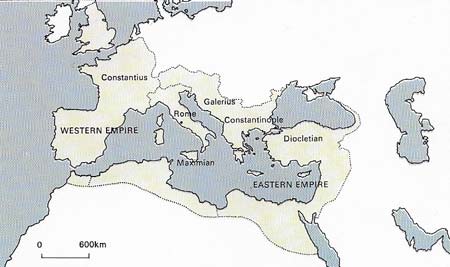
Figure 4. The reforms of Diocletian fundamentally altered the empire, splitting it into two almost independent halves. He and his Caesar Galerius were in charge of the crucial Danube and Eastern provinces, while Maximian and Constantius ruled the West. The emperors moved their headquarters nearer to the frontiers. Diocletian ruled from Nicomedia, near Constantinople.
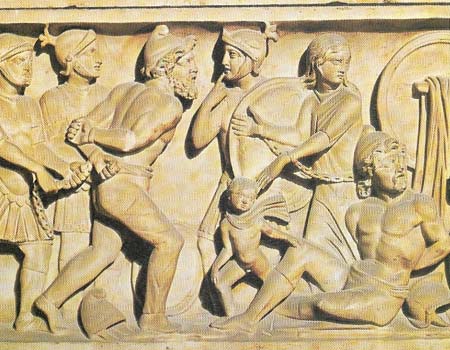
Figure 5. This detail from a sarcophagus shows Roman soldiers subduing barbarians. Some fighting emperors during the third century were able to hold the frontiers and push back invaders but generally the barbarians were allowed to enter the empire, settle, and infiltrate the army and administrative structure. During the fourth and early fifth centuries in the West the barbarian kingdoms took shape and their rise merged almost imperceptibly with the decline of the empire.
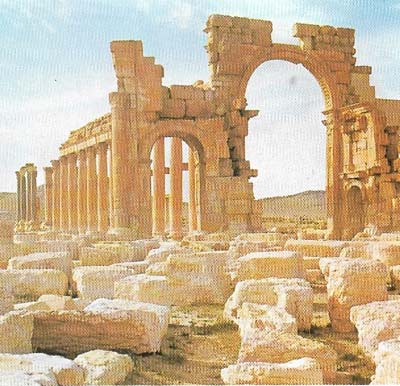
Figure 6. The influence of the Roman Empire continued as a civilizing force long after its fall. The massive grandeur of its buildings, such as these at Palmyra, remained as a visible reminder, while Rome's intellectual legacy was permanent.
After the murder of the Roman Emperor Commodus in AD 193 four rivals disputed the imperial succession. There was a costly civil war in which several major cities, including Antioch, Byzantium and Lyons, were sacked before Septimius Severus (reigned 193–211) was successful. Order was restored, but the military basis of imperial power then became more obvious.
Political anarchy and religious persecution
Septimius was succeeded by a family dynasty, but because a settled system of succession was lacking and because the legions increasingly realized that they had the power both to elect and to destroy emperors (Figure 1) there was continual unrest, with rivals being set up by local troops. In the 74 years from the death of Septimius to the accession of Diocletian (245–313) in 284 there were 27 emperors and many usurpers.
This political anarchy came at the worst possible time, for the barbarians were again pressing on the empire's frontiers. In 236 Alemanni and Franks crossed into Gaul and Goths poured over the Danube in 247 raiding the Balkans and killing the Emperor Decius (200–251). The Romans were forced either to allow the barbarians to settle within the frontiers or to buy them off.
In the east a new Persian dynasty, the Sassanids, invaded Syria and Asia Minor and then captured the Emperor Valerian (193–260) in 260 (Figure 2). His son and co-regent Gallienus (reigned 253–268) had to put down five rivals before recovering the lost eastern provinces. Aurelian (reigned 270–275) finally abandoned Dacia but began restoring the Danube and Rhine frontiers. The work was completed by Probus (reigned 276–282).
The unrest was accompanied by a breakdown of civil order and a collapse of the economy. Inevitably, men searched for scapegoats and the most obvious ones were the Christians. The Romans had always been highly tolerant of religions provided they accepted the divinity of the emperor, and many Oriental cults, including the worship of Mithras and Isis, had become widely popular. But the Christians, who refused to sacrifice to the emperor, were an easy target. They were barbarously persecuted by Decius and even more so by Valerian (reigned 253–260) (Figure 3).
Despite all the disasters, civilized life continued and the 3rd century saw the work of some of the greatest commentators on Roman law – Papinian, Paulus, and Ulpian – and considerable literary achievements.
Division of the empire
There was a desperate need for reorganization and in 285 Diocletian established a totally new governmental system. The empire was divided into Eastern and Western parts, each ruled by an "Augustus" with a "Caesar" as his deputy. The Augusti were to resign after 20 years and be succeeded by their Caesars. The imperial court moved away from Rome (Figure 4) and the provinces were replaced by dioceses ruled by a massive new bureaucracy and a reformed army. The whole system was supported by a new currency and heavy taxation and the emperors became absolute monarchs.
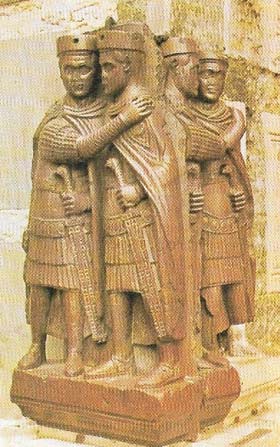 |
| Representing Diocletian's tetrarchy, this statue from St Mark's in Venice shows two Augusti clasping their Caesars, the deputies who would succeed them after 20 years. The chaos and disasters of the 3rd century forced Diocletian to impose ,major changes on the empire. His reforms, which were the first alterations to the system established by Augustus, can be seen as formalizing the practices of the years of anarchy when emperors reacted on an ad hoc basis to barbarian invasion nd civil strife. The emperor and his deputies became full-time military leaders and the whol system was supported by stringent new laws. |
Diocletian's reforms did not solve the succession problem and when he and his co-Augustus Maximian (reigned 286–305) resigned in 305 chaos followed. In 312 Constantine (c. 285–337) emerged victorious in the Western Empire in a battle at the Milvian Bridge, during which his armies fought under the Christian cross. In gratitude he made Christianity the official religion of the empire. In 324, on the death of the Eastern Emperor Licinius (reigned 311–323), Constantine reunited the empire and moved his capital to Byzantium, which was rebuilt as a totally Christian city with the name Constantinople. Henceforth the Eastern Empire and Christianity were to be closely identified.
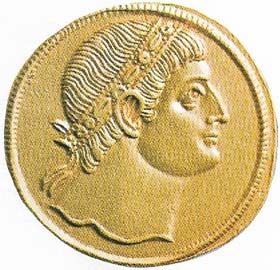 |
| Constantine the Great made the momentous decision that Christianity was to be the official religion of the empire. He also reunited the empire and moved the imperial capital from Rome to the strategically placed city of Byzantium (Constantinople), which he had rebuilt as a purely Christian city. Constantine identified with his new faith and put the whole weight of empire behind it. |
Constantine's death in 337 led to a division of the empire between his two sons; fighting followed until it was briefly reunited in 353. In 355, the Western Empire was placed under Julian, who briefly reunited the empire between 361 and 363. But thereafter the split became permanent.
The difference between the two halves was steadily being emphasized by the presence of barbarians in the West (Figure 5), as more tribes were settled within the frontiers, and by the development of a Christianity-dominated absolute empire in the East. In the West the army was by then almost entirely recruited from barbarians; as a result, its resistance was severely reduced.
Major barbarian invasions
Towards the end of the 4th century came renewed major invasions; in 376 the Visigoths were allowed to cross the Danube to settle, but they were so badly treated that they revolted in 378 and killed the Emperor Valens (c. 328–378) at Adrianople.
Other groups also crossed the frontiers; the Vandals moved through France and Spain to set up an independent kingdom in North Africa; Jutes, Angles and Saxons occupied Britain; Franks and Burgundians settled in northern France and Ostrogoths in Italy. By the middle of the 5th century the Western Empire had been almost completely occupied by barbarians, although a Romanized administration and culture survived. It came as no great surprise when German troops in Italy elected Odoacer, the Ostrogoth (reigned 476–493), as king and he deposed Romulus Augustulus (reigned 475–476) ending emperors in the West.
